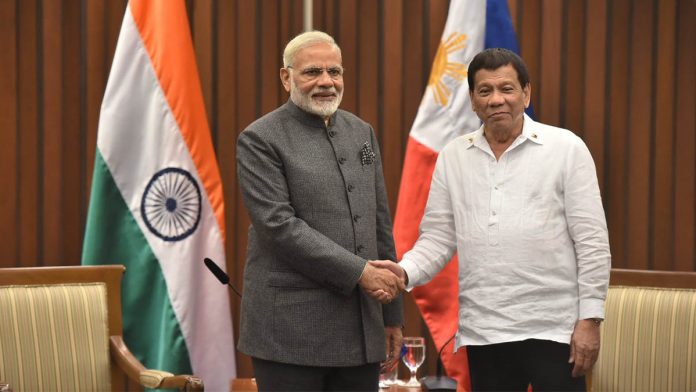India considers long-term economic ties with the Philippines, to boost Indo-Pacific initiative
By Nayanima Basu
In an effort to reduce China’s influence in ASEAN’s third-largest economy, the Modi government is planning to make rapid inroads in the Philippines.

File photo of Prime Minister Narendra Modi and Rodrigo Duterte, president of the Philippines | Twitter | @narendramodi
New Delhi: India is making rapid inroads in the Philippines by establishing long-term trade and economic ties even as it plans to have a preferential trade agreement (PTA) with the country. This agreement is expected to deepen bilateral ties between both countries thereby boosting the strategic Indo-Pacific construct.
The Philippines, which is the third-largest economy in terms of GDP in the 10-member Association of Southeast Asian Nations (ASEAN), will be the first such country with which the Narendra Modi government is planning a trade pact. The PTA will seek to enhance market access and open up opportunities for greater trade in goods and services, official sources told ThePrint.
According to sources, India is planning such mini-trade deals with those ASEAN countries with which it does not have a trade pact. New Delhi is doing this to better integrate itself in ASEAN’s supply chain networks and development in trade infrastructure since it is not a part of the Regional Economic Partnership Agreement (RCEP) that is expected to come into effect later this year.
The RCEP is a mega trade pact between ASEAN member states (Brunei, Cambodia, Indonesia, Laos, Malaysia, Myanmar, the Philippines, Singapore, Thailand, Vietnam) and its five trading partners — China, Japan, South Korea, Australia and New Zealand.
In 2019, India had walked out of the RCEP over concerns that Chinese goods and services could flood its markets.
At a recent business conference, organised by Confederation of Industry (CII) and Philippines Chamber of Commerce and Industry (PCCI), India’s Ambassador to the Philippines Shambhu S. Kumaran said the new strategic construct of Indo-Pacific is a key focus for both countries and that the PTA will help in deepening ties between the two sides.
Meanwhile, sources added, the PTA will also be a “step in the right direction” to boost India’s ‘Act East Policy’, which is aimed at reducing China’s growing influence in the region.
In infrastructure development, Indian companies such as the Adani Group, GMR, L&T and IRCON among others are also exploring investment opportunities in potential sectors such as railways, airports, shipbuilding, ports and urban infrastructure in the Philippines.
At the same conference, Ramon M. Lopez, Minister, Department of Trade and Industry in Philippines, said the proposed PTA will enable “enhanced market access” that will “make use of numerous mutually beneficial opportunities open to India and the Philippines as economic partners in the Indo-Pacific region”.
According to Rajeshwari Pillai Rajagopalan, distinguished fellow and head (nuclear and space policy initiative), Observer Research Foundation, the PTA can be effective in establishing trade and commercial connections between the two countries.
“With India not being a party to the RCEP, New Delhi has no choice but pursue the bilateral route in creating and nurturing strategic economic linkages. In that context, PTA can be an effective instrument in establishing large trade and commercial connections. The PTA can facilitate and expedite such investments in the Philippines,” Rajagopalan told ThePrint.
Defence, security ties between India and the Philippines
The Philippines, sources said, is one of the few countries within ASEAN that has been able to “stand up against” China.
It was the first country to go to an international tribunal against Beijing for violating the United Nations Convention on the Law of the Sea (UNCLOS) with its actions in the South China Sea. The Philippines questioned the legal validity of China’s claims on the nine-dash line — a demarcation line in the South China Sea — under UNCLOS.
Therefore, India believes that under its ‘Act East Policy’, the Philippines is poised to become a key partner as it seeks to enhance its Indo-Pacific strategy. This is also boosted by the fact that the political relationship between the Narendra Modi government and Rodrigo Duterte administration is growing.
In November 2020, during the last joint commission meeting between India and the Philippines that was co-chaired by External Affairs Minister S. Jaishankar and Teodoro Locsin Jr., Secretary, Department of Foreign Affairs of the Philippines, both sides had vowed to further strengthen defence and maritime cooperation.
Prior to that, in June 2020, Prime Minister Modi and President Duterte held a conversation over the phone where New Delhi emphasised that Manila is a “vital partner” in the Indo-Pacific region.
While a summit meeting between both the leaders is on the cards later this year, a defence ministers meeting is expected to take place before that as both countries are also planning joint naval drills and counterterrorism measures, sources said.
India is also eyeing the export of the BrahMos cruise missiles to Manila. This could be the first export of the missile that is jointly developed by India and Russia.
“The PTA supplement the already strategic nature of bilateral security and defence ties including the possible sale of BrahMos cruise missiles to the Philippines. While the Philippines is welcoming India and this offers huge potential in furthering India’s Act East Policy, the handicap, as in many other cases, has been Indian capacity. Precisely because of the capacity constraints, India might benefit from partnering with economically more capable powers to match up to the growing strategic competition in the Indo-Pacific,” Rajagopalan said.
In terms of cooperation in Covid vaccines, the Serum Institute of India has already signed a deal with the Philippines to give 30 million doses of Novavax, meanwhile, Bharat Biotech has applied for emergency use of its vaccine there.
Source: The Print
